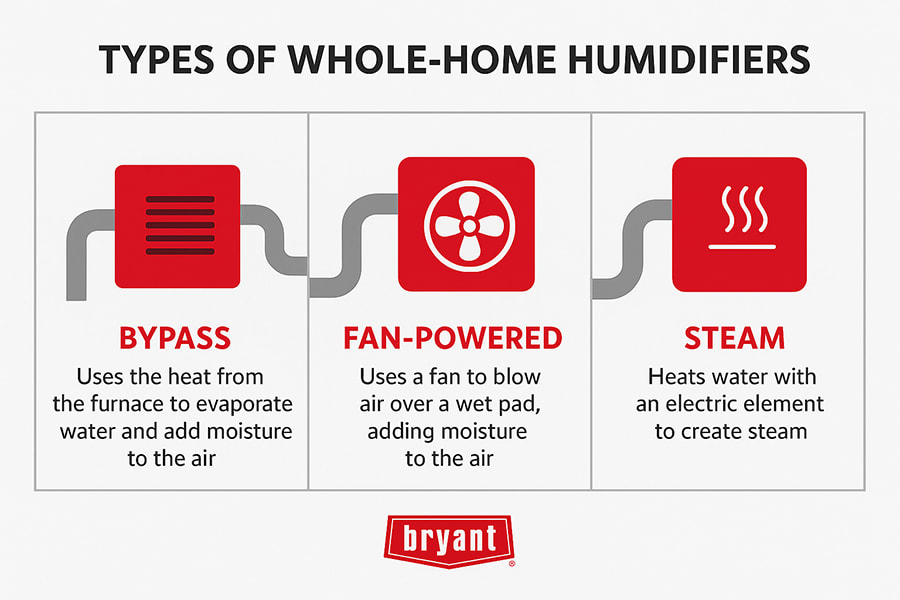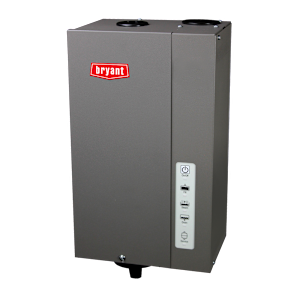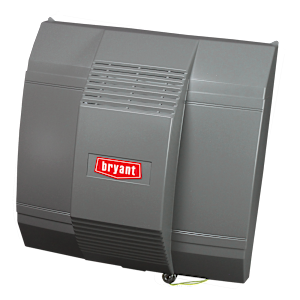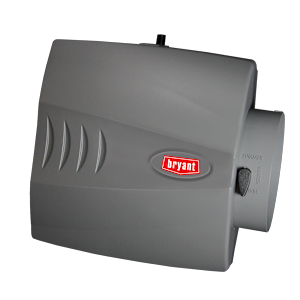About The Author: Travis Baugh is a Digital Brand Marketing Manager for Bryant, where he creates clear, helpful content to guide homeowners through heating, cooling, and indoor air quality decisions. His goal is to empower readers with the knowledge they need to choose the right comfort solutions for their home—confidently and comfortably.
Understanding Whole House Humidifier Types
Managing indoor humidity is essential for comfort, protecting your home, and supporting better indoor air quality. If you’re comparing whole house humidifier types, this guide explains how the main technologies work and where each fits best within a ducted HVAC system. We’ll cover the fundamentals behind bypass, fan-powered, and steam humidifiers, along with the advantages, limitations, and maintenance considerations for each. As a leader in home comfort, Bryant offers whole-home solutions engineered to integrate with compatible furnaces and air handlers, delivering even moisture distribution throughout your living spaces.

Bypass Humidifiers
Bypass humidifiers are among the most common whole house humidifier types and install directly into your home’s ducted heating system. In a Bryant bypass humidifier, warm supply air moves through a water panel (also known as an evaporator pad). As air passes across the moistened surface, it absorbs water vapor and then “bypasses” back into the return duct to distribute humidity through your existing ductwork. A built-in humidistat monitors indoor relative humidity and signals the system to add moisture as needed, helping maintain consistent comfort throughout your home. This approach makes a bypass model a practical whole house furnace humidifier option within many types of whole home humidifiers.
Key advantages include quiet operation, energy-efficient performance, and minimal moving parts, which can reduce humidifier maintenance. Because bypass models leverage your HVAC system’s airflow rather than a dedicated fan, they typically use less electricity than powered alternatives. Bryant bypass humidifiers are designed for reliable, steady moisture output and can be paired with compatible smart thermostats for convenient control and monitoring. Potential drawbacks to note are that output depends on furnace or air handler operation, and proper installation requires access to an appropriate bypass duct. In very large homes or layouts with limited duct access, sizing and placement should be evaluated to ensure effective coverage and airflow when selecting among types of whole home humidifiers.
For best results, replace the water panel regularly, keep HVAC filters clean to support airflow, and schedule periodic system checks. A Bryant dealer can recommend the right bypass humidifier capacity and help fine-tune settings for your climate and home layout as you compare whole house humidifier types.
Bryant offers three bypass humidifier options: the Preferred™ Series Large Bypass Humidifier (HUMCRLBP), the Preferred™ Series Small Bypass Humidifier (HUMCRSBP), and the Preferred™ Series Water Saver Bypass Humidifier (HUMCRWBP).
Fan-Powered Humidifiers
Fan-powered humidifiers use an integrated, low-voltage fan to draw warm air from the supply duct across a water-saturated pad. As the air passes through, it absorbs moisture and is distributed through your ductwork to balance indoor humidity. Unlike bypass designs that rely solely on furnace blower pressure, the dedicated fan maintains consistent moisture output even when the furnace or air handler isn’t moving large volumes of air. Bryant fan-powered humidifiers are engineered to integrate smoothly with compatible Bryant heating systems, supporting a whole-home strategy for humidity control and serving as another strong whole house furnace humidifier choice within the main types of whole home humidifiers.
For larger homes or multi-zone systems, fan-powered models can be particularly effective. Their built-in fan boosts moisture delivery across longer duct runs, helping reduce dry-air issues—such as static electricity, dry skin, or gaps in wood flooring—more evenly from room to room. Maintaining recommended indoor humidity can also help you feel warmer at lower thermostat settings, which may contribute to reduced heating energy use.
To keep a Bryant fan-powered humidifier operating efficiently, replace the water panel at the start of each heating season, or more frequently if you have hard water. Clean the housing and fan intake periodically to remove dust or mineral deposits, and verify that the water supply line and drain remain clear and leak-free. Confirm the humidistat—or connected smart control—is calibrated to your comfort target and local climate conditions. For added peace of mind, schedule annual maintenance with a Bryant dealer to inspect electrical connections, confirm proper airflow, and fine-tune settings for optimal moisture output and long-term dependability for this whole house furnace humidifier configuration.
Bryant's Preferred™ Series Large Fan-powered Humidifier (HUMCRLFP) quietly and evenly distributes moisture and provides whole house comfort.
Steam Humidifiers
Steam humidifiers are a popular choice among whole house humidifier types because they create moisture on demand by boiling water to produce clean steam, then distributing it through your home’s ductwork. Unlike bypass or fan-powered evaporative models that rely on furnace heat and airflow, steam units use an internal electric element to heat water independently. Bryant steam humidifiers are designed to deliver precise humidity control by generating consistent steam output regardless of your heating system’s run cycle, helping you achieve your target relative humidity quickly and accurately.
When evaluating energy efficiency, it’s helpful to balance electrical consumption with performance and comfort goals. Steam humidifiers typically use more electricity than evaporative styles because they actively heat water. However, they can be more effective at reaching set humidity levels in tightly built homes, larger floorplans, or in regions with very dry winter air. Maintaining proper water quality and following recommended service intervals—such as cleaning or replacing steam canisters where applicable—can support efficient operation and long-term reliability among these whole house humidifier types.
Steam systems are well-suited for applications where precise, year-round humidity control is a priority, including homes with hardwood floors, musical instruments, fine furnishings, or occupants with respiratory sensitivities. They also pair effectively with variable-speed HVAC systems or situations where the heating equipment doesn’t run frequently enough to support evaporative humidification. If you’re upgrading to a whole-home solution, a Bryant steam humidifier can integrate with compatible thermostats and indoor air quality products to deliver balanced comfort, helping protect your home and enhance indoor air quality across the entire living space as you consider different types of whole home humidifiers.
Bryant's Preferred™ Series Steam Humidifier (HUMCRSTM) keeps you comfortable in drier seasons by providing a more fixed level of humidity control.

Choosing the Right Whole House Humidifier
Selecting the best whole house humidifier starts with assessing your home’s needs and how the unit will integrate with your HVAC system. Key factors include capacity, efficiency, and total cost. Capacity refers to moisture output—often measured in gallons per day—and should align with your home’s square footage, insulation, air leakage, and typical winter dryness. Oversized units can waste water and energy, while undersized units may struggle to reach target humidity. Efficiency matters as well: look for models designed to deliver consistent moisture with smart controls that help maintain optimal indoor relative humidity, typically between 30% and 50%. Cost considerations should include upfront price, water and energy use, pad or canister replacement, and long-term maintenance. These comparisons will help you differentiate among whole house humidifier types and decide whether a whole house furnace humidifier or steam option best fits your needs.
Compatibility with your HVAC system is also important for dependable performance. Bryant offers solutions designed to work with a range of forced-air systems, including furnaces and air handlers. Consider whether your system layout supports bypass or fan-powered installation and whether you prefer integration with an existing thermostat or a dedicated humidity control. Proper duct placement, supply and return airflow, access to a reliable water line, and adequate drainage are essential. A Bryant dealer can assess static pressure, airflow rates, and the available humidifier installation location to recommend the right configuration and capacity for your home when choosing among types of whole home humidifiers.
Connect With A Bryant Dealer On The Right Humidifier For You
Connect with a Bryant dealer to find the right whole home humidifier for your home’s size, climate, and comfort needs and to get a quote for humidifier cost. Their experts can recommend a system that integrates seamlessly with your HVAC equipment for balanced humidity and improved air quality. Professional guidance ensures you choose the most efficient and cost-effective solution for lasting comfort. Schedule an appointment today.
Explore Bryant Humidifiers
Choose a Bryant humidifier to maintain optimal humidity levels in your home, enhancing comfort and air quality. It helps prevent dry skin, static electricity, and respiratory issues by adding moisture to the air, especially during the colder months. With quiet, energy-efficient operation, a Bryant humidifier integrates seamlessly with your HVAC system, providing consistent moisture control throughout your home. Durable and reliable, it ensures a healthier living environment by promoting ideal humidity levels year-round.
Learn More About Humidifiers
- Understand the different between an air purifier and humidifier
- Learn what does a humidifier do?
- Find out what humidity should my house be at?
- Explore similarities and differences between a humidifier vs dehumidifier
- Learn humidifier benefits
- Seek help with humidifier repair





